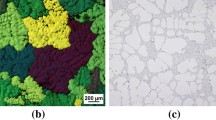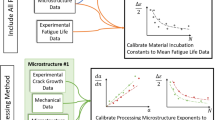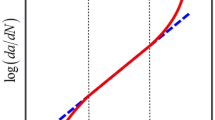Abstract
Light structural metals have been extensively applied throughout the transportation sector in recent years with greater impetus to reduce vehicle weight and enhance energy efficiency. However, their use is restricted by the engineering challenge of fatigue crack growth and the need to understand, simulate, and predict crack propagation mechanisms with respect to materials’ microstructure. To address this need, a comprehensive computational methodology has been developed using the extended finite element method to predict fatigue crack interaction mechanisms with characteristic microstructural features. Mathematical formulations and algorithmic development are rigorously addressed, with specific emphasis on the incorporation of relevant physical phenomena of plasticity and particle debonding/fracture. This approach is validated by comparison with analytical models and experiments on cast aluminum–silicon alloys using digital image correlation. The proposed methodology constitutes a framework for the successful development, application, and advancement of computational design of materials. Ultimately, this contributes to material/process selection and design for structural integrity by enabling rapid assessment of fatigue crack growth resistance without prior testing, thereby reducing of the extent of costly experimental investigations.











Similar content being viewed by others
Abbreviations
- A:
-
Domain of the interaction integral
- \( {\mathbf{A}} \) :
-
Matrix operator of spatial derivatives
- \( {\bar{\mathbf{a}}} \) :
-
Sign function enriched degrees of freedom
- B :
-
Strain–displacement matrix with small strain (linear) approximation
- \( {\tilde{\mathbf{B}}} \) :
-
Strain-displacement matrix for finite strains
- \( {\mathbf{b}} \) :
-
Body force loads
- C :
-
Elastic stiffness tensor
- C ep :
-
Elasto-plastic stiffness tensor
- C :
-
Paris law constant
- C RO :
-
Ramberg-Osgood parameter
- da :
-
Crack growth increment
- d g :
-
Incremental plastic consistency parameter
- dK :
-
Mixed mode crack driving force
- dN :
-
Crack cycle number increment
- \( {\mathbf{E}}^{G} \) :
-
Green strain tensor
- E :
-
Elastic modulus
- \( {\mathbf{f}} \) :
-
Global force vector
- e-j, p, s, t :
-
Iteration indices
- \( f^{trial} \) :
-
Trial function for radial return algorithm
- G :
-
Shape function derivative matrix
- G :
-
Yield function
- \( \mathcal{G} \), ℋ:
-
The set of Gaussian quadrature points
- \( {\mathbf{I}}_{2x2} \) :
-
Two-by-two identity matrix
- I (1), I (2) :
-
Interaction integral for calculation of the J-integral
- \( {\mathbf{J}} \) :
-
Jacobian matrix
- \( {\mathcal{J}} \) :
-
The set of enriched nodes
- K :
-
Global stiffness matrix
- K I, K II :
-
Mode I and II stress intensity factors
- \( {\mathbf{K}}_{T} \) :
-
Global tangent stiffness matrix for simulations with non-linear constitutive behavior
- L :
-
Matrix differential operator
- \( l_{1} ,l_{2} \) :
-
Element edge lengths along global Cartesian axes
- M S :
-
Second Piola–Kirchhoff stress tensor matrix
- m :
-
Newton-Rapson iteration counter
- m Paris :
-
Paris Law exponent
- \( {\mathbf{N}} \) :
-
Total shape function matrix
- N :
-
Element shape functions
- \( {\mathcal{N}} \) :
-
The set of nodes
- n :
-
Load step iteration counter
- \( {\bar{\mathbf{n}}},{\bar{\mathbf{t}}} \) :
-
Normal and tangential vectors defining cohesive elements
- n RO :
-
Ramberg-Osgood exponent
- \( {\bar{\mathbf{n}}}_{{\varGamma_{d} }} \) :
-
Normal vector to contour Γd
- \( {\mathcal{P}} \) :
-
The set of enrichment functions
- q :
-
A weighting function defined by Moës [4] for determining the interaction integral
- R :
-
Stress ratio
- R NR :
-
Newton-Raphson residual in radial return algorithm
- r, θ :
-
Polar coordinate radial and angular components
- S :
-
Second Piola–Kirchhoff stress tensor
- T :
-
Cohesive stiffness matrix
- T :
-
Plastic modulus; slope of the yield curve used in the radial return algorithm
- \( {\mathbf{t}}_{c} \) :
-
Cohesive tractions on the contour Γt
- \( {\mathbf{t}}_{s} \) :
-
Surface tractions on the discontinuity contour Γd
- \( t_{n} ,t_{t} \) :
-
Normal and tangential traction components
- \( {\mathbf{u}} \) :
-
Global displacement vector
- \( {\bar{\mathbf{u}}} \) :
-
Standard nodal degrees of freedom (displacement vector)
- \( {\bar{\mathbf{u}}}_{int} \) :
-
Interpolated displacement vector
- \( u^{\left( 1 \right)} ,u^{\left( 2 \right)} \) :
-
Displacement states used in calculating the interaction integral
- \( W^{\left( 1 \right)} ,W^{\left( 2 \right)} \) :
-
Strain energy density
- w :
-
Gaussian quadrature weights
- x :
-
Position in Cartesian coordinates
- \( {\bar{\mathbf{x}}}^{*} \) :
-
Closest point projection of point x onto Γd used in calculating level set functions
- α :
-
The set of four crack tip enrichment functions
- α p :
-
Internal plastic evolution variable
- Γ d :
-
Discontinuity contour
- Γ t :
-
Traction contour
- β :
-
The set of six plastic crack tip enrichment functions
- \( {\bar{\varvec{\Delta }}} \) :
-
Discretized displacement jump across cohesive element
- \( \Delta_{n} ,\Delta_{t} \) :
-
Normal and tangential displacements across a cohesive element
- Δγ :
-
Plastic consistency parameter
- δ c :
-
Critical separation distance in cohesive model
- δ :
-
Kronecker delta
- ε :
-
Strain
- \( \varepsilon^{dev} \) :
-
Deviatoric strain
- ε p :
-
Plastic strain
- \( \theta_{c} \) :
-
Critical angle for crack propagation
- \( \theta_{fracture} \) :
-
Angle for particle fracture
- ν :
-
Poisson ratio
- ξ, η :
-
Gaussian quadrature coordinates
- σ :
-
Cauchy stress tensor
- σ 1 :
-
First principal stress
- \( \sigma_{11} ,\sigma_{22} ,\sigma_{12} \) :
-
Cartesian stress components (along x1, x2, and shear)
- \( \sigma^{\left( 1 \right)} ,\sigma^{\left( 2 \right)} \) :
-
Cauchy stress used in calculating the interaction integral
- \( \sigma^{trial} \) :
-
Trial stress for radial return algorithm
- σ y :
-
Yield strength
- φ :
-
Level set function
- φ n :
-
Normal work of separation in cohesive model
- \( {\varvec{\Psi}} \) :
-
Newton–Raphson residual
- \( \psi_{p} \) :
-
Local enrichment function (sign, ramp, crack tip)
- \( \bar{\psi } \) p :
-
Shifted local enrichment function (sign, ramp, crack tip)
- Ω, Ω A, Ω B :
-
Domain of integration, Ω = ΩA⋃ΩB
- ω :
-
Crack tip angle in global coordinate system
References
Ortiz M, Leroy Y, Needleman A (1987) A finite element method for localized failure analysis. Comput Methods Appl Mech Eng 61:189–214. https://doi.org/10.1016/0045-7825(87)90004-1
Belytschko T, Black T (1999) Elastic crack growth in finite elements with minimal remeshing. Int J Numer Meth Eng 45:601–620. https://doi.org/10.1002/(SICI)1097-0207(19990620)45:5%3c601:AID-NME598%3e3.0.CO;2-S
Dolbow J (1999) An extended finite element method with discontinuous enrichment for applied mechanics. Ph.D. dissertation, Duke University
Moës N, Dolbow J, Belytschko T (1999) A finite element method for crack growth without remeshing. Int J Numer Meth Eng 46:131–150. https://doi.org/10.1002/(SICI)1097-0207(19990910)46:1%3c131:AID-NME726%3e3.0.CO;2-J
Daux C, Moës N, Dolbow J, Sukumar N, Belytschko T (2000) Arbitrary branched and intersecting cracks with the extended finite element method. Int J Numer Meth Eng 48:1741–1760. https://doi.org/10.1002/1097-0207(20000830)48:12%3c1741:AID-NME956%3e3.0.CO;2-L
Dolbow J, Moës N, Belytschko T (2001) Extended finite element method for modeling crack growth with frictional contact. Comput Methods Appl Mech Eng 190:6825–6846. https://doi.org/10.1016/S0045-7825(01)00260-2
Moës N, Belytschko T (2002) Extended finite element method for cohesive crack growth. Eng Fract Mech 69:813–833. https://doi.org/10.1016/S0013-7944(01)00128-X
Stolarska M, Chopp DI (2003) Modeling thermal fatigue cracking in integrated circuits by level sets and the extended finite element method. Int J Eng Sci 41:2381–2410. https://doi.org/10.1016/S0020-7225(03)00217-9
Réthoré J, Gravouil A, Combescure A (2005) A combined space-time extended finite element method. Int J Numer Meth Eng 59:1075–1102. https://doi.org/10.1002/nme.1368
Elguedj T, Gravouil A, Combescure A (2006) Approximate extended functions for X-FEM simulation of plastic fracture mechanics. Comput Methods Appl Mech Eng 195:501–515. https://doi.org/10.1016/j.cma.2005.02.007
Elguedj T, Gravouil A, Combescure A (2007) A mixed augmented Lagrangian-extended finite element method for modelling elastic-plastic fatigue crack growth under unilateral contact. Int J Numer Meth Eng 71:1569–1597. https://doi.org/10.1002/nme.2002
Huynh DBP, Belytschko T (2009) The extended finite element method for fracture in composite materials. Int J Numer Meth Eng 77:214–239. https://doi.org/10.1002/nme.2411
Yazid A, Abdelkader N, Abdelmadjid H (2009) A state-of-the-art review of the X-FEM for computational fracture mechanics. Appl Math Modell 33:4269–4282. https://doi.org/10.1016/j.apm.2009.02.010
Wang Z, Ma L, Wu L, Yu H (2012) Numerical simulation of crack growth in brittle matrix of particle reinforced composites using the XFEM technique. Acta Mech Solida Sin 25:9–21. https://doi.org/10.1016/S0894-9166(12)60002-0
Ye C, Shi J, Cheng GJ (2012) An extended finite element method (XFEM) study on the effect of reinforcing particles on the crack propagation behavior in a metal-matrix composite. Int J Fatigue 44:151–156. https://doi.org/10.1016/j.ijfatigue.2012.05.004
Liu W, He Z, Yao W, Li M, Tang J (2014) XFEM simulation of the effects of microstructure on the intergranular fracture in high strength aluminum alloy. Comput Mater Sci 84:310–317. https://doi.org/10.1016/j.commatsci.2013.12.008
Noël L, Duysinx P (2016) Shape optimization of microstructural designs subject to local stress constraints within an XFEM-level set framework. Struct Multidisc Optim 54:2323–2338. https://doi.org/10.1007/s00158-016-1642-8
Melenk JM, Babuška I (1996) The partition of unity finite element method: basic theory and applications. Research report No. 96-01. TICAM, University of Texas at Austin
Sethian JA (1999) Level set methods and fast marching methods: evolving interfaces in computational geometry, fluid mechanics, computer vision, and materials science, 2nd edn. United Kingdom, Cambridge
Bouhala L, Shao Q, Koutsawa Y, Younes A, Núñez P, Makradi A, Belouettar S (2013) An XFEM crack-tip enrichment for a crack terminating at a bi-material interface. Eng Fract Mech 102:51–64. https://doi.org/10.1016/j.engfracmech.2013.02.023
Naumov M (2012) Parallel incomplete-LU and Cholesky factorization in the preconditioned iterative methods on the GPU. NVIDIA Technical Report NVR-2012-003
Press WH, Teukolsky SA, Vetterling WT, Flannery BP (2002) Numerical recipes in C. United Kingdom, Cambridge
Griffiths DV (1994) Stiffness matrix of the four-node quadrilateral element in closed form. Int J Numer Meth Eng 37:1027–1038. https://doi.org/10.1002/nme.1620370609
Erdogan F, Sih GC (1963) On the crack extension in plates under plane loading and transverse shear. J Basic Eng 85:519–525. https://doi.org/10.1115/1.3656897
Sih GC (1974) Strain-energy-density factor applied to mixed mode crack problems. Int J Fract 10:305–321. https://doi.org/10.1007/BF00035493
Tanaka K (1974) Fatigue crack propagation from a crack inclined to the cyclic tensile axis. Eng Fract Mech 6:493–507. https://doi.org/10.1016/0013-7944(74)90007-1
Rice JR, Rosengren GF (1968) Plane strain deformation near a crack in a power law hardening material. J Mech Phys Solids 16:1–12. https://doi.org/10.1016/0022-5096(68)90013-6
Yaw LL (2012) Nonlinear static—1D plasticity—various forms of isotropic hardening. Walla Walla University
Simo JC, Hughes TJR (1998) Computational inelasticity. Springer, New York
Spangenberger AG, Lados DA, Coleman M, Birosca S, Hardy M (2016) Microstructural mechanisms and advanced characterization of long and small fatigue crack growth in cast A356-T61 aluminum alloys. Int J Fatgiue 97:202–213. https://doi.org/10.1016/j.ijfatigue.2016.12.029
Xu X, Needleman A (1994) Numerical simulation of fast crack growth in brittle solids. J Mech Phys Solids 42:1397–1434. https://doi.org/10.1016/0022-5096(94)90003-5
Babout L, Brechet Y, Maire E, Fougères R (2004) On the competition between particle fracture and particle decohesion in metal matrix composites. Acta Mater 52:4517–4525. https://doi.org/10.1016/j.actamat.2004.06.009
Beremin FM (1981) Cavity formation from inclusions in ductile fracture of A508 steel. Metal Trans A 12(723):32. https://doi.org/10.1007/BF02648336
Lewis CA, Withers PJ (1995) Weibull modelling of particle cracking in metal matrix composites. Acta Metall Mater 43:3685–3699. https://doi.org/10.1016/0956-7151(95)90152-3
Gross-Weege A, Weichert D, Broeckmann C (1996) Finite element simulation of crack initiation in hard two-phase materials. Comput Mater Sci 5:126–142. https://doi.org/10.1016/0927-0256(95)00064-X
AFGROW version 5.02.05.19, www.afgrow.net. Accessed online 19 Mar 2017
ASTM STP E647 – 13 (2013) Standard test method for measurement of fatigue crack growth rates. ASTM International, West Conshohocken
Carroll J, Abuzaid W, Lambros J, Sehitoglu H (2010) An experimental methodology to relate local strain to microstructural texture. Rev Sci Instrum 81:083703. https://doi.org/10.1063/1.3474902
Rice JR (1968) A path independent integral and the approximate analysis of strain concentration by notched and cracks. J Appl Mech 35:379–386. https://doi.org/10.1115/1.3601206
Acknowledgements
This work was supported by the National Science Foundation (Grant Number 1151588) and the members of the Integrative Materials Design Center (iMdc) at Worcester Polytechnic Institute. The authors also thank Dr. Tiantian Zhang for conducting the digital image correlation experiments.
Author information
Authors and Affiliations
Corresponding author
Additional information
Publisher's Note
Springer Nature remains neutral with regard to jurisdictional claims in published maps and institutional affiliations.
Appendices
Appendices
1.1 Appendix A: numerical integration of enriched elements
The assumptions of PU are violated by discontinuities and singularities cutting the support of enriched elements, and the procedure for numerical integration must be revised. Enriched elements are divided into non-overlapping “sub-triangle” elements that do not cross discontinuities by a Delaunay triangulation. The points used for the triangulation are those where an element’s support is cut (at the intersection of an edge with either crack flanks or particle interfaces), vertices of kinks in the crack flanks or particle interfaces, and the crack tip. An example of the creation of sub-triangles for crack tip and sign enriched elements is shown in Fig. 12 for a quadrilateral element. Gaussian quadrature is performed in a two-level procedure from sub-triangle Gauss coordinates, to quadrilateral Gauss coordinates, to global Cartesian coordinates (two coordinate transforms to calculate the total Jacobian). It should also be noted that this method does not increase the number of degrees of freedom.
Numerical integration of the finite element mesh in a is conducted by dividing the parent quadrilateral elements into sub-triangles that do not cross the discontinuity. Examples of crack tip enriched elements b and sign enriched elements c identify the triangulation points, sub-triangles, and Gauss points
The conventional shape functions required for numerical integration of the governing equation are given for a four-node quadrilateral element by Eq. (A1), and require modification for enriched elements. The enriched shape functions for elements containing the crack flanks, interface, and/or crack tip are obtained by multiplying the standard shape functions by the shifted enrichment functions (evaluated relative to a particular node and its respective enriched degree(s) of freedom, as was done in Eq. (7)). The total shape function for an enriched node is then the concatenation of the standard and enriched shape functions, given by Eq. (A2).
The strain–displacement matrices are related to the element shape functions by the spatial derivative. They are obtained by element-wise pre-multiplication of each shape function by the matrix differential operator, L, given in Eq. (A3). This results in the standard and enriched strain–displacement matrices, Eqs. (A4) and (A5). The spatial derivatives of the standard and enriched shape functions can then be calculated by the chain rule, given in Eqs. (A6)–(A10) for rectangular elements. For the crack tip functions, which are defined in local polar coordinates at the crack tip, additional coordinate transformations to local Cartesian coordinates (\( x_{1}^{'} \), \( x_{2}^{'} \)) and then to global Cartesian coordinates (\( x_{1} \), \( x_{2} \)) must be conducted, Eq. (A11), resulting in the derivatives required for Eq. (A10). Then, similar to the shape functions, the total strain–displacement matrix B is the concatenation of the standard and enriched strain–displacement matrices, or \( {\mathbf{B}} = \left[ {\begin{array}{*{20}c} {{\mathbf{B}}^{std} } & {{\mathbf{B}}^{enr} } \\ \end{array} } \right] \).
1.2 Appendix B: calculation of the interaction integral
The mode I and II stress intensity factors, Eqs. (A12) and (A13), for a crack tip in a homogeneous domain are calculated by means of the interaction integral which is determined with Eqs. (A14)–(A23). Much of the procedure is analogous to the construction of the global stiffness matrix and will not be discussed in depth here. It is calculated as a contour integral [39] around the crack tip(s), typically using the elements contained within a circle with a radius one to three element widths. The first two terms on the right hand side of Eq. (A14) must be solved by calculating the stress and strain for the present (1) and auxiliary (2) states, Eqs. (A15)–(A22). The third term, the interaction strain energy, W, is the sum of term-wise multiplication of Eqs. (A16) and (A22), given in Eq. (A23). The weight function q is given by Möes et al. [4] to take a value of 1 within the contour around the crack tip and zero elsewhere (i.e., only contributions from elements within the domain of the contour integral are considered).
Rights and permissions
About this article
Cite this article
Spangenberger, A.G., Lados, D.A. Extended finite element modeling of fatigue crack growth microstructural mechanisms in alloys with secondary/reinforcing phases: model development and validation. Comput Mech 67, 87–105 (2021). https://doi.org/10.1007/s00466-020-01921-2
Received:
Accepted:
Published:
Issue Date:
DOI: https://doi.org/10.1007/s00466-020-01921-2





